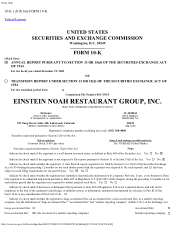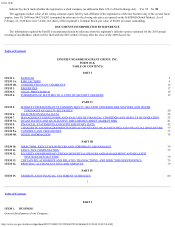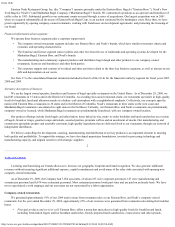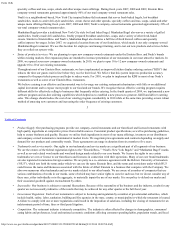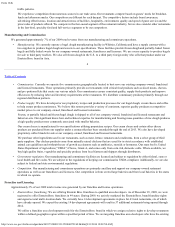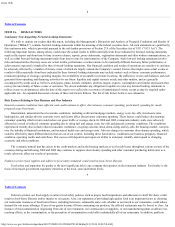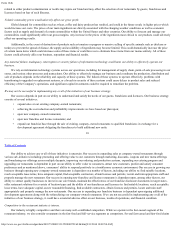Einstein Bros 2009 Annual Report Download - page 9
Download and view the complete annual report
Please find page 9 of the 2009 Einstein Bros annual report below. You can navigate through the pages in the report by either clicking on the pages listed below, or by using the keyword search tool below to find specific information within the annual report.
Form 10-K
http://www.sec.gov/Archives/edgar/data/949373/000119312510040721/d10k.htm[9/11/2014 10:09:50 AM]
related to either product contamination or recalls may injure our brand and may affect the selection of our restaurants by guests, franchisees and
licensees based on fear of such illnesses.
Volatile commodity prices would adversely affect our gross profit.
Global demand for commodities such as wheat, coffee and dairy products has resulted, and could in the future result, in higher prices which
would increase our costs. The prices of our main ingredients are directly associated with the changing weather conditions as well as economic
factors such as supply and demand of certain commodities within the United States and other countries. Our ability to forecast and manage our
commodities could significantly affect our gross margins. Any increase in the prices of the ingredients most critical to our products could adversely
affect our operating results.
Additionally, in the event of destruction of products such as tomatoes or peppers or massive culling of specific animals such as chickens or
turkeys to prevent the spread of disease, the supply and availability of ingredients may become limited. This could dramatically increase the price
of certain menu items which could decrease sales of those items or could force us to eliminate those items from our menus entirely. All of these
factors could adversely affect our business, reputation and financial results.
Any material failure, inadequacy, interruption or security failure of information technology could harm our ability to effectively operate our
business.
We rely on information technology systems across our operations, including for management of supply chain, point-of-sale processing in our
stores, and various other processes and transactions. Our ability to effectively manage our business and coordinate the production, distribution and
sale of products depends on the reliability and capacity of these systems. The failure of these systems to operate effectively, problems with
transitioning to upgraded or replacement systems, or a breach in security of these systems could cause delays in product sales and reduced
efficiency of the Company’ s operations, and significant capital investments could be required to remediate the problem.
We may not be successful in implementing any or all of the initiatives of our business strategy.
Our success depends in part on our ability to understand and satisfy the needs of our guests, franchisees and licensees. Our business strategy
consists of several initiatives:
• expand sales at our existing company-owned restaurants;
• achieving the cost reduction and profitability improvements we have based our plan upon;
• open new company-owned restaurants;
• open new franchise and license restaurants; and
• expand our franchise base through the sale of existing company-owned restaurants to qualified franchisees in exchange for a
development agreement obligating the franchisees to build additional new units.
10
Table of Contents
Our ability to achieve any or all of these initiatives is uncertain. Our success in expanding sales at company-owned restaurants through
various sub-initiatives including: promoting and offering value to our customers through marketing, discounts, coupons and new menu offerings
and broadening our offerings across multiple dayparts, improving our ordering and production systems, expanding our catering program and
upgrading our restaurants is dependent in part on our ability to offer value to consumers, attract new customers, predict and satisfy consumer
preferences and as mentioned above, consumers’ ability to respond positively in a troublesome economic environment. Our success in growing our
business through opening new company-owned restaurants is dependent on a number of factors, including our ability to: find suitable locations,
reach acceptable lease terms, have adequate capital, find acceptable contractors, obtain licenses and permits, recruit and train appropriate staff and
properly manage the new restaurant. Our success in opening new franchise and license restaurants is dependent upon, among other factors, our
ability to: attract quality businesses to invest in our core brands, maintain the effectiveness of our franchise disclosure documents in target states,
offer restaurant solutions for a variety of location types and the ability of our franchisees and licensees to: find suitable locations, reach acceptable
lease terms, have adequate capital, secure reasonable financing, find available contractors, obtain licenses and permits, locate and train staff
appropriately and properly manage the new restaurants. Our success in expanding our franchise business is dependent upon signing additional
development agreements along with the refranchising our company-owned restaurants. If we are not successful in implementing any or all of the
initiatives of our business strategy, it could have a material adverse effect on our business, results of operations, and financial condition.
Competition in the restaurant industry is intense.
Our industry is highly competitive and there are many well-established competitors. While we operate in the fast-casual segment of the
restaurant industry, we also consider restaurants in the fast-food and full-service segments as competitors. Several fast-casual and fast-food chains

